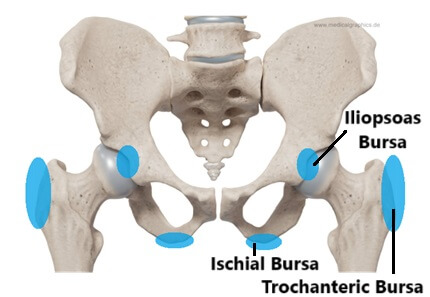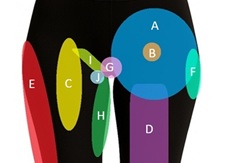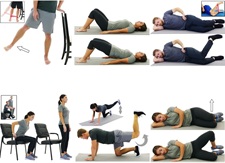- Home
- Hip Pain Diagnosis
- Hip Bursitis
Hip Bursitis
Written By: Chloe Wilson, BSc(Hons) Physiotherapy
Reviewed by: KPE Medical Review Board
Hip bursitis is a common cause of hip pain that can affect different parts of the hip.
Irritation and inflammation of one of the hip bursa results in a deep, aching hip pain which typically gets worse with activity.
Bursa are small, jelly-like pockets of fluid that sit between bones and soft tissues to reduce friction and ensure smooth movement. However, if they are overloaded from excessive pressure or repetitive friction, they can swell up and cause problems.
In this article, we’ll explore the different types of hip bursitis, their causes, symptoms, diagnostic methods, and the most effective treatments for each.
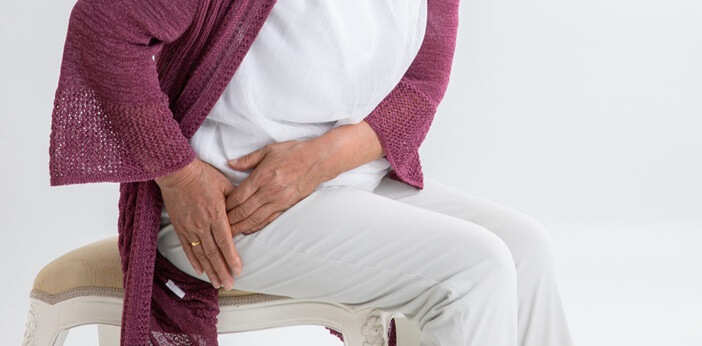
What Is Hip Bursitis?
Hip bursitis is a common condition where one or more of the bursae around the hip joint become inflamed. Bursae are small, fluid-filled sacs that act as cushions between bones, tendons, and muscles, reducing friction and allowing smooth movement in the joint.
Bursa are found all over the body, but in the hip, there are three main pairs:
- Trochanteric Bursa: found on the outer hip
- Iliopsoas Bursa: found at the front of the hip
- Ischial Bursa: found under the sitting bones
When these bursae become irritated or inflamed, it leads to bursitis of the hip, causing pain and restricted movement. This inflammation can result from injury, repetitive movement, or underlying medical conditions.
Hip bursitis is common in athletes and active individuals, but it can also affect those with underlying conditions like arthritis or after trauma to the hip area. It is a common cause of hip pain at night.
Types Of Hip Bursitis
There are several types of hip bursitis depending on which bursa is affected. Each type has distinct characteristics, locations of pain, and causes, though they share common features of inflammation and discomfort.
1. Trochanteric Bursitis
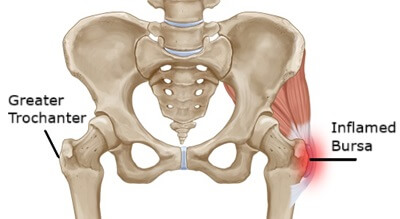
Trochanteric bursitis is the most common type of hip bursitis and involves inflammation of the bursa located near the greater trochanter, which is the bony prominence on the outer side of the hip.
The greater trochanteric bursa cushions the tendons that pass over this bone e.g. glutes and ITB.
Inflammation of this bursa results in outer hip pain that can radiate down the side of the thigh. Trochanteric bursitis is often caused by repetitive movements, improper posture, or underlying conditions like arthritis.
Around 90% of people with trochanteric bursitis also develop gluteal tendonitis.
2. Iliopsoas (Groin) Bursitis
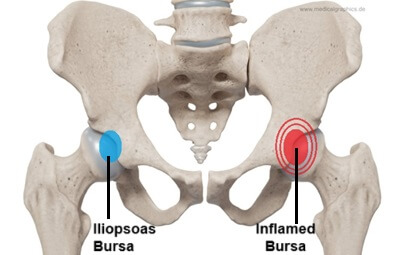
Also known as Iliopectineal Bursitis, this condition involves inflammation of the iliopsoas bursa located in the front of the hip, near the groin.
The bursa helps cushion the iliopsoas muscle as it passes over the pelvic bone. Inflammation here causes pain deep in the groin or front of the hip and can be aggravated by activities that involve hip flexion, such as walking uphill, running, or sitting for long periods.
Iliopsoas bursitis is common in runners, dancers, and individuals involved in activities that require frequent hip flexion.
3. Ischial (Sitting) Bursitis
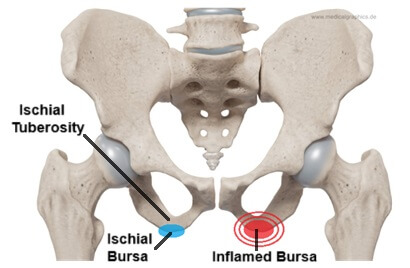
Ischial bursitis, sometimes called "Weaver's Bottom," affects the hip bursa located between the ischial tuberosity (the sitting bones) and the gluteal muscles.
The ischial bursa provides cushioning when sitting. Inflammation of the ischial bursa can cause pain in the lower buttocks and can make sitting, especially on hard surfaces, uncomfortable.
Ischial bursitis is often seen in people who sit for long periods on hard surfaces, cyclists, and individuals who experience trauma to the area e.g. falling onto the buttocks.
Causes of Hip Bursitis
Hip bursitis can be caused by a range of factors, including:
- Repetitive Motions or Overuse: Repetitive activities that involve the hip, such as running, cycling, or stair climbing, can put excessive stress on the hip bursae. This overuse can lead to irritation and inflammation over time, particularly in athletes or individuals with physically demanding jobs.
- Direct Trauma or Injury: A fall, blow to the hip, or other forms of direct trauma can cause the hip bursae to become inflamed. This is especially true for trochanteric bursitis and ischial bursitis, where impact injuries to the outer hip or buttocks can trigger inflammation.
- Prolonged Pressure: Sitting for long periods on hard surfaces or in awkward positions can lead to the development of ischial or iliopsoas bursitis. This prolonged pressure compresses the bursa, causing irritation and inflammation.
- Underlying Medical Conditions: Inflammatory conditions such as rheumatoid arthritis, osteoarthritis, or gout can increase the risk of developing bursitis hip. These conditions promote inflammation throughout the joints, including the hip bursa.
- Poor Posture and Abnormal Gait: Misalignment in the legs, hips, or spine can cause abnormal strain on the hip bursa. Postural issues, leg length discrepancies, and improper footwear can contribute to repetitive friction and stress on the bursae, especially in trochanteric bursitis.
- Sudden Increase in Physical Activity: Rapidly increasing the intensity or duration of physical activity can overload the hip joints, leading to inflammation of the hip bursa. This is common in individuals who increase their running distance, intensity, or start a new sport without proper conditioning.
Hip Bursitis Symptoms
Hip bursitis symptoms will vary depending on the type but typically include:
- Hip Pain: a deep, aching pain is a common feature in all types of bursitis hip but the location of the pain will vary depending on which bursa is affected.
Trochanteric Bursitis - causes pain on the outer side of the hip that can radiate down the thigh.
Iliopsoas Bursitis - results in deep, sharp pain in the groin or front of the hip.
Ischial Bursitis - leads to pain in the lower buttock or back of the thigh, especially when sitting on hard surfaces - Stiffness and Limited Range of Motion: People with hip bursitis often experience stiffness in the affected area, reducing hip range of motion and making it difficult to move the hip joint normally. Walking, climbing stairs, or performing hip movements can become painful and restricted. The stiffness is often worse first thing in the morning or after prolonged sitting
- Pain Worsened by Activity: Activities like walking, running, sitting for prolonged periods, or even lying on the affected side can exacerbate the pain. Hip flexion and rotation typically increase the discomfort
- Tenderness and Swelling: The hip may be tender to touch, especially over the affected bursa. In some cases, swelling and warmth may be present in the area
- Night Pain: hip pain while sleeping is a common feature of hip bursitis, particularly if your sleep position places pressure through an inflamed bursa
Diagnosing Hip Bursitis
A proper diagnosis is crucial to differentiate bursitis of the hip from other causes of hip and upper thigh pain. Diagnosis is made through the following steps:
- Medical History and Physical Examination: A healthcare provider will take a detailed medical history to understand when the symptoms began and what activities or positions worsen the pain. A physical exam will involve palpating the hip area to check for tenderness and assessing the range of motion and strength. Special tests such as the Thomas Test may also be used.
- Imaging Studies: Your doctor may send you for imaging studies to confirm the diagnosis of hip bursitis and to rule out other possible hip problems. X-rays may be taken to rule out bone-related conditions such as arthritis or fractures. Ultrasound and MRI scans can visualize soft tissues like the bursae, providing clear images of inflammation or fluid build-up in the hip bursa.
- Diagnostic Injection: In some cases, a doctor may inject a local anesthetic into the bursa. If the pain is temporarily relieved, this confirms that the hip bursa is the source of the problem.
Differential Diagnosis
Hip bursitis shares symptoms with several other conditions that must be ruled out before confirming the diagnosis:
- Hip Osteoarthritis: Osteoarthritis of the hip can cause similar pain and stiffness, but the pain is often more widespread and involves deeper joint issues. X-rays are typically used to distinguish osteoarthritis from bursitis in the hip.
- Hip Labrum Tear: A labral tear can mimic the symptoms of hip bursitis, particularly with groin pain. The labrum is a thick ring of cartilage that lines the hip socket and helps keep the joint stable and moving smoothly. An MRI is often needed to identify labral damage.
- Hip Tendinitis: Hip flexor tendonitis can cause groin or front hip pain similar to iliopsoas bursitis. Gluteal tendonitis is extremely common with trochanteric bursitis causing outer hip pain. Hamstring tendonitis can mimic the symptoms of ischial bursitis.
- Hip Impingement: Femoroacetabular impingement is where there is extra bone growth on either the ball or socket part of the hip joint (or both). Hip impingement causes friction in the joint which causes pain in and around the hip
- Muscle Strain: Overstretching of one of the hip muscles can cause pain similar to hip bursitis. A hip flexor strain causes front hip pain and a groin strain causes inner thigh pain.
- Lumbar Or Nerve Pain: Bursitis hip can sometimes be mistaken for problems in the lumbar spine or nerves in the lower back as both can refer pain down the thigh and leg. However, pain from spine or nerve problems are often accompanied by tingling or numbness, which are never symptoms of bursitis. Find Out More >
- Snapping Hip Syndrome: With this condition there is a snapping or popping noise or sensation when yo move your hip. This is usually caused by a tendon flicking over part of the hip bone. Snapping hip syndrome may or may not be painful.
#CommissionsEarned from Amazon on qualifying purchases
Hip Bursitis Treatment
Treatment for bursitis of the hip will depend on which bursa is affected but focuses on reducing inflammation, managing pain, and improving mobility. Common hip bursitis treatments include:
- Rest and Activity Modification: Avoid activities that aggravate the pain, such as running, stair climbing, or sitting for prolonged periods. Resting the hip can help reduce inflammation in the bursa.
- Ice and Heat Therapy: Applying an ice pack to the affected area can reduce swelling and relieve pain. Heat can also be used to relax the muscles and improve blood flow to the area.
- Medications: Non-steroidal anti-inflammatory drugs (NSAIDs), such as ibuprofen/Advil or naproxen, can reduce inflammation and pain.
- Physical Therapy: A physical therapist can develop a tailored hip bursitis exercise program to strengthen the muscles around the hip, improve flexibility, and correct any posture or gait abnormalities. Hip strengthening exercises targeting the core, hip, hamstring and gluteal muscles can help to improve support around the hip, and stretching exercises help to reduce pressure on the hip bursa
- Corticosteroid Injections: For persistent or severe cases, a corticosteroid injection directly into the bursa can provide significant relief by reducing inflammation. This procedure is often done under ultrasound guidance for accuracy.
- Surgical Intervention: Surgery is rarely needed for hip bursitis. However, in cases where conservative treatment fails, a bursectomy (removal of the bursa) may be considered. The surgery is usually minimally invasive and performed arthroscopically.
You can find out more about the best treatments for each types of hip bursitis in the following articles:
How To Prevent Hip Bursitis
Taking proactive steps to prevent hip bursitis is essential for people who are at risk of developing the condition. Here are some preventive measures:
- Warm-Up and Stretching: Before engaging in physical activity, make sure to warm up properly and do hip stretching exercises to prevent overuse injuries.
- Maintain Good Posture: Correcting posture and avoiding slouching or poor alignment during activities can reduce the strain on the hip bursa. Proper body mechanics should be maintained while sitting, walking, and exercising.
- Strengthening Exercises: Incorporating exercises that strengthen the muscles around the hip joint, particularly the glutes, core, and hamstrings, can help support the hip and reduce stress on the bursae.
- Avoid Prolonged Sitting: If you often sit for extended periods, especially on hard surfaces, take frequent breaks and use cushioning to relieve pressure on the ischial bursae. You can get specially designed cushions that help to reduce pressure through the hip bursa
- Gradually Increase Activity: If you are starting a new exercise regimen or increasing your physical activity level, do so gradually to avoid overloading the hip joints.
- Wear Supportive Footwear: Ensure that your shoes provide proper cushioning and support, especially if you engage in activities like running or walking for long distances.
FAQs On Bursitis Hip
1. How Do You Get Rid Of Bursitis In Your Hip?
1. How Do You Get Rid Of Bursitis In Your Hip?
Treatment for bursitis of the hip typically includes rest, ice, anti-inflammatory medications, physical therapy, hip strengthening exercises, hip stretches and corticosteroid injections. In most cases, these methods reduce inflammation and relieve pain. Severe cases may require a bursectomy.
2. Does Walking Help Hip Bursitis?
2. Does Walking Help Hip Bursitis?
Walking can be beneficial in mild cases of bursitis of the hip, as long as it doesn't exacerbate symptoms. However, excessive or improper walking technique may worsen the inflammation. Stick to low-impact activities until hip bursitis symptoms improve.
3. What Can Hip Bursitis Be Mistaken For?
3. What Can Hip Bursitis Be Mistaken For?
Bursitis hip symptoms are often mistaken for conditions such as hip flexor pain, hip osteoarthritis, labral tears, femoroacetabular impingement, snapping hip syndrome, sciatica, groin strain or tendinitis, which also cause hip pain and stiffness. It is important to see your doctor for an accurate diagnosis to ensure you get the right treatment.
4. Will Hip Bursitis Heal On Its Own?
4. Will Hip Bursitis Heal On Its Own?
In some cases, mild bursitis of the hip may resolve with rest and activity modification. However, persistent or severe cases often require treatment, such as physical therapy, hip bursitis exercises or medication, to fully heal. In general, it will get better quicker the sooner you start bursitis hip treatment.
5. What Not To Do With Hip Bursitis?
5. What Not To Do With Hip Bursitis?
Avoid activities that strain the hip joint, such as running, climbing stairs, sitting for long periods, or lying on the affected side, as these can worsen the condition. You want to avoid anything that places increased pressure or friction on the hip bursa.
6. What Flares Up Hip Bursitis?
6. What Flares Up Hip Bursitis?
Repetitive motions, overuse, prolonged sitting or standing, and activities that involve excessive hip movement can flare up bursitis of the hip. Poor posture, tight or weak hip muscles may also contribute to flare-ups.
7. How Long Does Hip Bursitis Take To Heal?
7. How Long Does Hip Bursitis Take To Heal?
Hip bursitis can take a few weeks to several months to heal, depending on the severity and the treatment approach. Consistent management with rest, physical therapy, and medications can speed up recovery.
Summary
Hip bursitis is a common and painful condition that can significantly affect your mobility and quality of life. The three main types of bursitis of the hip, trochanteric bursitis, iliopsoas bursitis and ischial bursitis, are caused by inflammation of different bursae around the hip joint.
Bursitis of the hip is often triggered by overuse, trauma, or underlying health conditions and can lead to localized pain, tenderness, and difficulty with movement. Fortunately, most cases of bursitis in the hip respond well to conservative treatments like rest, physical therapy, and anti-inflammatory medications.
By understanding the causes, symptoms, and treatments, you can take steps to manage bursitis in the hip effectively and prevent its recurrence.
You may also be interested in the following articles:
- Outer Hip Pain
- Hip Flexor Pain
- Pain In Top Of Thigh
- Hip Pain Diagnosis Charts
- Hip Impingement
- Pain Above The Knee
- Quads Strain
- Hip Muscle Anatomy
- Hip Stretching Exercises
Related Articles
Hip Pain At Night
October 2nd, 2025
Hip Pain Diagnosis
September 16, 2025
Hip Strengthening
September 24, 2025
Last Updated: September 24th, 2025
Next Review Due: September 24th, 2027
